Brewing in Hardanger
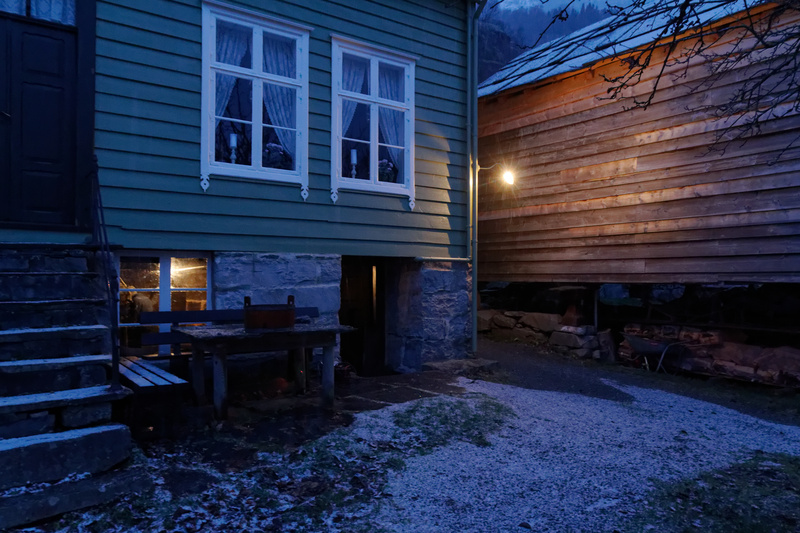
The cellar where we brewed |
Hardanger in western Norway used to be famous for its traditional culture in general, and also for its farmhouse ale. In the early 20th century, several of the major lager breweries in Oslo made "Hardangerøl", replicas of the farmhouse ale from Hardanger. And in 1973, Norwegian national TV even made a documentary about the local brewing. And in 2014 we accidentally met a brewer from Hardanger. So I'd been looking for brewers in this area, but not found any who were willing to talk. Until my friend Morten came across a family in Aga, Hardanger.
When we arrived on the morning of the brew the two brothers Reidar and Jarand Eitrheim had already started. On the grass outside the brew cellar they'd set up a gas burner to heat water for the juniper infusion. Like just about all other farmhouse brewers in Norway, they were brewing with juniper infusion rather than water.
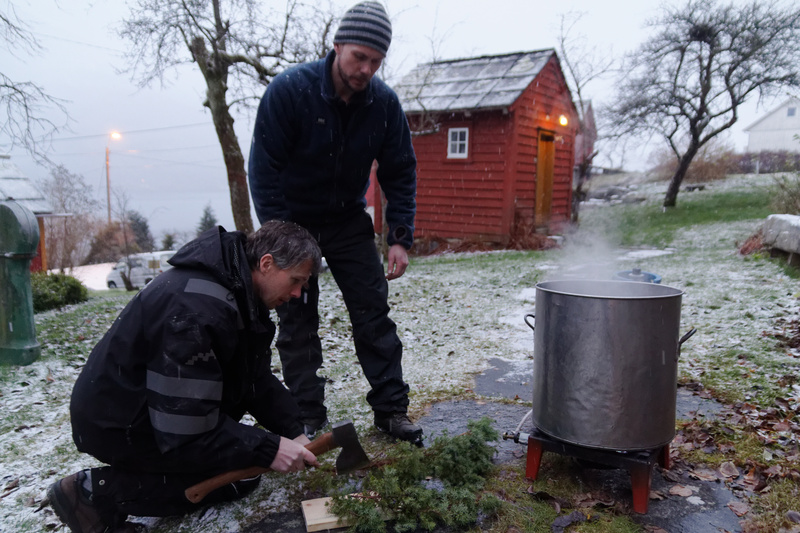
Preparing juniper infusion |
Inside the cellar they'd started the fire underneath the big copper kettle. This was in early December, so the cellar was cold and damp, and condensation was gathering on the kettle and running down into the firewood below. "At least I hope it's condensation," said Reidar. "Or the kettle may have sprung a leak." Later, when the kettle had heated up the water stopped dripping into the firewood, so it really was condensation.
While the water was heating up, the brothers were giving the wooden brewing gear a last cleaning. Preparing the vessels for use had been a long process. The weekend before they'd sent us a photo of the mashtun leaking water in every direction like some kind of poorly constructed lawn watering device. In the intervening week they'd kept it soaked in water, and the wood had eventually swollen up and closed the leaks.
The brewing gear comes from their grandfather, Jakob, and he's the one who taught them brewing. I try asking when they learned but they can't really answer. "We were running in and out of the brewhouse since we were little kids," says Jarand, "and we just kind of picked it up. Some people say they're born with skis on their feet, while we ..." He doesn't need to finish.
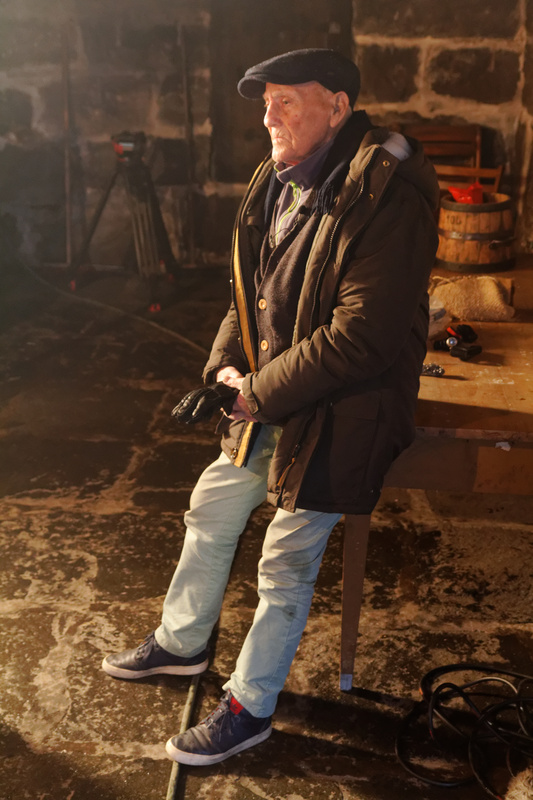
Jakob |
Later in the day Jakob comes by. He was born in 1920, so he's 96 now, and leaves the brewing to his grandkids. He learned to brew in 1937, he says, when he was 17. Stop a moment to consider this. That's the year WWII began in China, and two years before it broke out in Europe. He's been brewing beer a long time. The brewing vessels, he says, were inherited from his grandfather, so they must be from the 1860s, at least. (Yes, the decade of the American Civil War.)
As a teenager, Jakob told me, he had the job of preparing the wooden mashtun for the brewing. He had to carry it on his back up the steep mountainside to a brook. There it had to be left, to soak and swell. Then he had to carry it back down again, now much heavier because of the water. "It was hard work," he said. Half an hour later I watch the brothers wrestle the same mashtun through the door and down the 4-5 steps into the cellar. They're grown men, moving it maybe 10 meters, but even so they do it together.
As they're preparing the juniper infusion I'm puzzled by one thing: a juniper branch hung in the smoke from the fireplace. The brothers tell me this is to get some smoke flavour. Jakob used to hang a sack with 10kg malts in the fireplace to get that flavour. That makes me ask how he dried his malts, and the answer is he used to dry it in the sun on the roof of an outhouse. Surely that can't be traditional, I ask? No, originally they had a badstu, which gave lightly smoked malts.
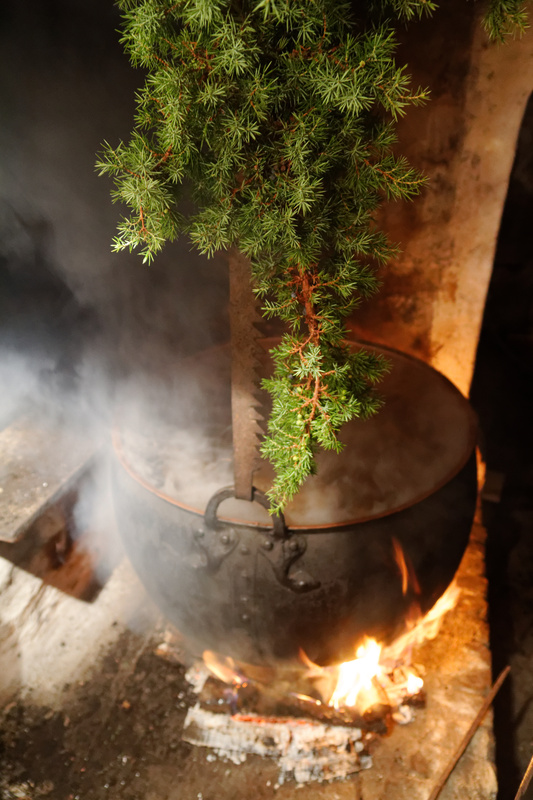
Smoking the juniper |
With that the pieces of the puzzle fall into place. Way back they had the traditional kiln, which makes lightly smoked malts. Then they lost that, and Jakob improvised by sun-drying and then smoking a part of the malts. And now his grandkids have turned it into this smoked branch of juniper. That's evolution of modern farmhouse ale right there. I do get the impression the grandkids aren't that fond of the smoke flavour, though.
Anyway, once the juniper infusion is hot enough, we're ready to start mashing. The brothers prepare the filter in the bottom of the mashtun. First comes a layer of alder sticks. These have been soaked in water first, so that they won't float up and ruin everything. On top goes juniper branches. Jarand uses an axe and chops off the tips of the branches only, then stuffs them into the bottom.
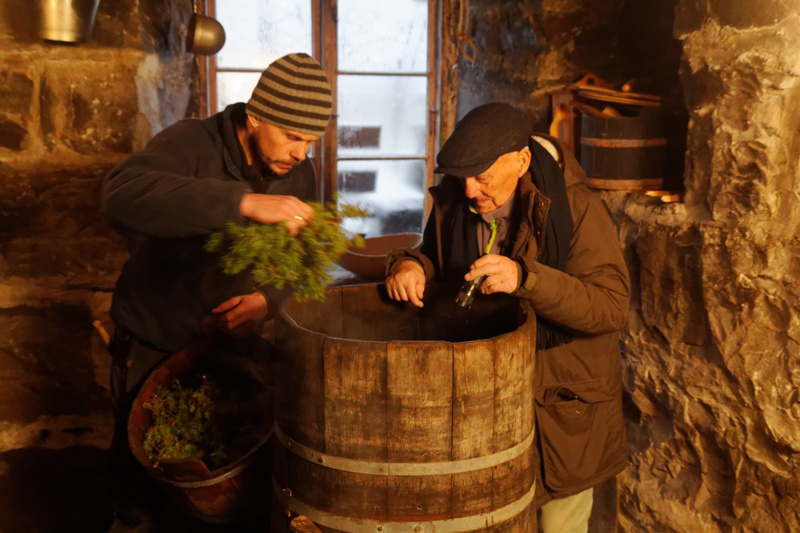
Reidar laying the filter while Jakob holds the flashlight |
The malts are dropped into the mashtun and hot juniper infusion added. They're aiming for 72C, says Jakob, but there's some confusion with their thermometer, which doesn't agree with mine. Anyway, that's the intended temperature. Once that's hit the mashtun has malt sacks laid on top, and we wait.
About an hour later starts the run-off, into a steel bucket. The bucket is poured into the copper kettle in the fireplace, because Hardanger is in the boiled wort area. The wort is boiled for 2-3 hours with hop flowers. After a while, they get a good rolling boil going, and eventually a good bit of the water will evaporate.
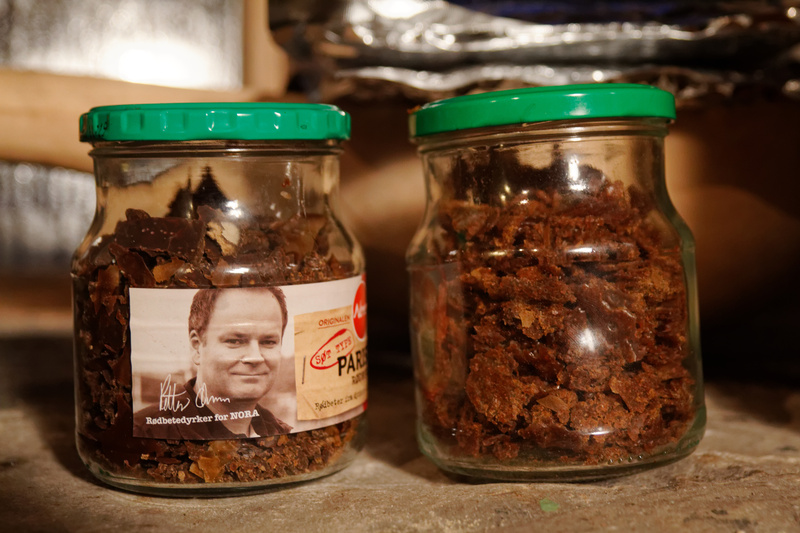
The kveik |
At this point, the kveik comes out. They harvest it "wherever the kveik is, usually on the bottom," then Jakob dries it on a shoe-rack. He has one of these shoe-racks with heating to dry the shoes, which he wraps with baking parchment, and then sets the heat on the lowest setting. Once it's dried into chips he puts it in glass jars. Jakob says he has many, many generations of kveik at home, going back at least 15 years. (This, by the way, is #14 Eitrheim).
Jakob says he changed kveik when he moved in the 1950s, but it turns out he changed to his brother's kveik, which was basically the same one, since it came from the farm. According to Jakob it came from his grandfather originally, so it should have been in the family since the 1860s. Before that Jakob doesn't know.
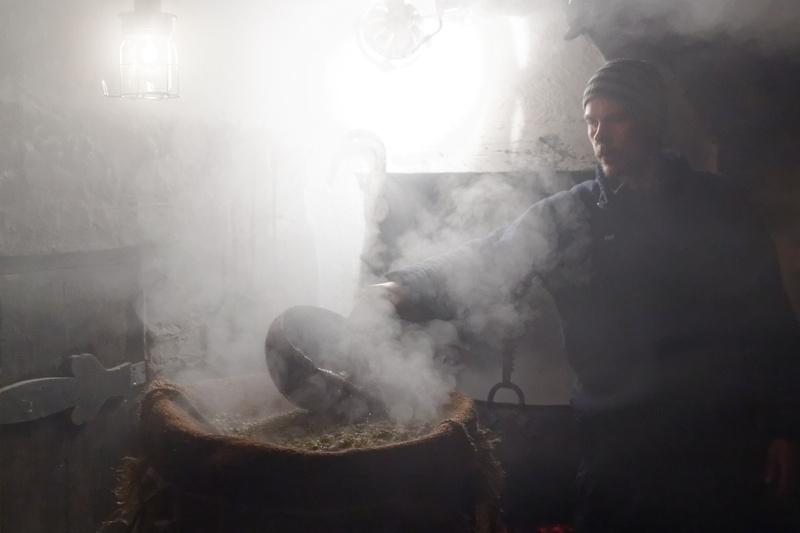
Filtering the hops |
Once the boiling is finished, the brothers put a cloth filter over the fermenter (which earlier was the mashtun). The wort is now transferred by ladle into the fermenter, and the hop flowers are removed by the filter.
They're not quite finished adding ingredients yet, however, because Jakob likes to add rock candy to the wort. It's hard to buy these days, so he's built up a reserve at home. Jakob drops a good amount of sugar into the wort, while the brothers look on, frowning but saying nothing. This is a source of contention between the brothers and their grandpa, because Jakob likes the beer strong, but the brothers like being able to walk straight after drinking a pint.
I guess the brothers have a point, because I measured the OG to 1.125. With normal attenuation (75%) that would give us a strength of 12.3%. Not exactly a beer you'd drink by the pints. (And, yes, handling that much alcohol is normal for kveik.) On the other hand, they're brewing 110 liters, so you need several kilos of sugar for it to really make any noticeable difference.

The wort boiling away |
Now the wort has to be cooled to 37C so that the yeast can be pitched. They have a copper spiral, so this goes pretty fast. In the old days Jakob used to scream when pitching, but the brothers don't do it any more. Once the yeast is pitched, the fermenter is wrapped with cloth which they strap down, so that it won't get too cold. They ferment 3-4 days before it's time for oppskåke (the racking).
The brothers kindly sent us a bottle of the beer by mail so we could taste it. Unfortunately, this time the kveik was dead. They think the shoe-rack might have accidentally been set too warm when they dried it, so the result was that the beer never fermented out properly, and ended up sweeter than it should have been.
The beer had very little head, because of the low carbonation. Hazy, surprisingly dark brown body. Aroma of fruity caramel and perhaps, possibly, a trace of funk. By taste it was very sweet. Very, very sweet. So sweet my lips stuck together, and the glasses afterwards were coated in a sugary film. But it was still kind of balanced, because there was a very strong, bitter backbone in there, from the hops and the juniper. The flavour was again dark, almost burnt caramel with mineraly notes, lots of fruit from the kveik, ending in a dry, wooden flavour. It reminded me of syrup on rye crisp bread. A very nice beer, but it should have fermented out more and become drier.
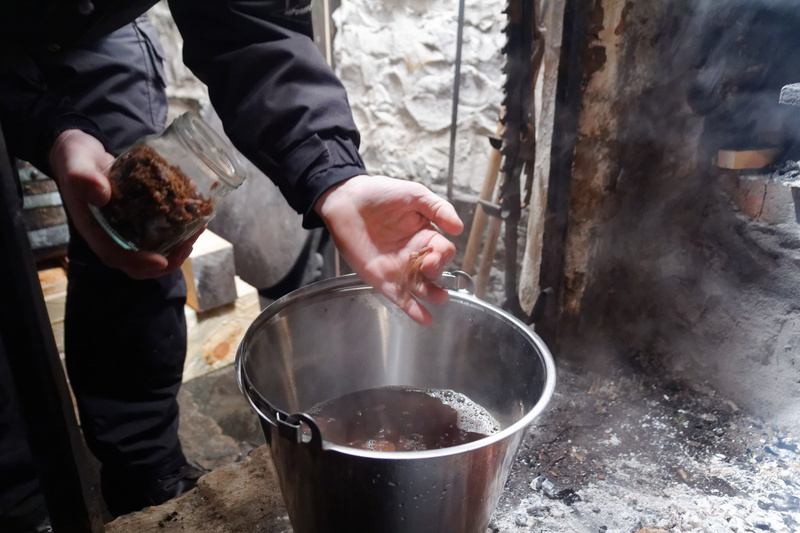
Pitching kveik in the starter |
The brothers say that until the 90s lots of people in Hardanger were brewing their own beer using kveik. Then, in 1992, it became legal to homebrew without making the malts yourself, which of course led to homebrew shops being established. In the one in Hardanger, the owner would always say "...and then you need yeast, of course." He also claimed the kveik was full of bacteria and other bad stuff. Gradually people stopped using kveik, and now there's just a few brewers who still have it.
Probably the reason people stopped using the yeast is not just the shop owner. Reidar thinks people also stopped because brewing with kveik is more uncertain, in the sense that it's easier to end up in a situation where it won't ferment or your beer is infected. And he is of course right about that.
Still, I'm hoping this blog post, my book, and all the attention kveik and traditional farmhouse ale are getting can make people in Hardanger change their minds so they start brewing again. If this type of beer is to live on it's the people in Hardanger who have to keep it alive.
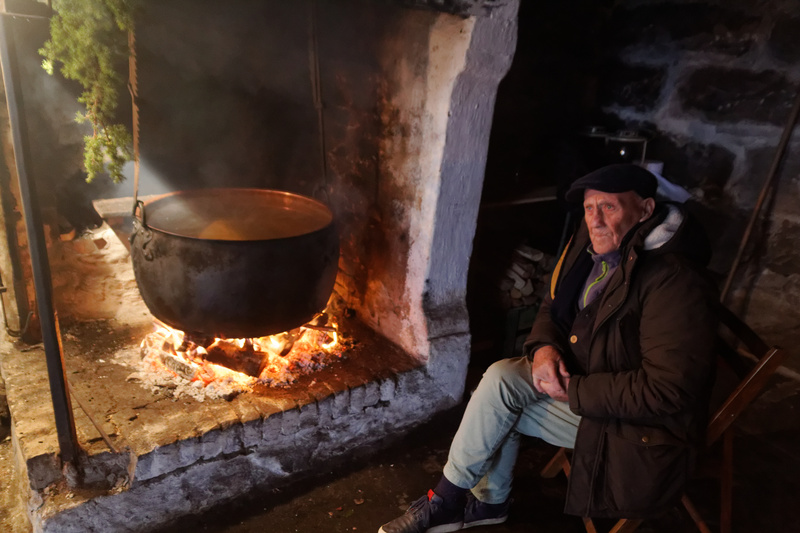
Jakob by the fireplace |
As luck would have it, this was published on Jakob's 98th birthday. Happy birthday, Jakob!
The recipe
This is for a batch of 110 liters, which is what they brewed.
Malt bill: 25 kilos of pale malts, and 25 kilos of Munich malts.
Hops: 600 grams Magnum (15%, added at start of boil). 100 grams each of 2.4% Mittelfrüh and 5.5% Tettnang 20 minutes before the end. To be honest I don't think the aroma hops contributed anything much, but the theoretical IBU is 81. Which matches how it tasted.
Mash for an hour starting at 72C and probably finishing not much below. Mash pH 4.5 at the start. Run off slowly, then boil powerfully 2-3 hours with hops.
Filter out the hops and add rock candy until the brothers Eitrheim start looking uneasy. Then add a good bit more. Reidar estimates they used about 300 grams.
Cool the wort to 37C, then pitch #14 Eitrheim and let it ferment for 3-4 days before racking. Harvest the yeast where you find it, which will probably be the bottom.
It can be served right away, or stored for at least a year. Alcohol strength is not clear, but definitely above 10%. OG should be 1.125 (but it can definitely be lower). The proper FG we don't know, unfortunately.
The back story
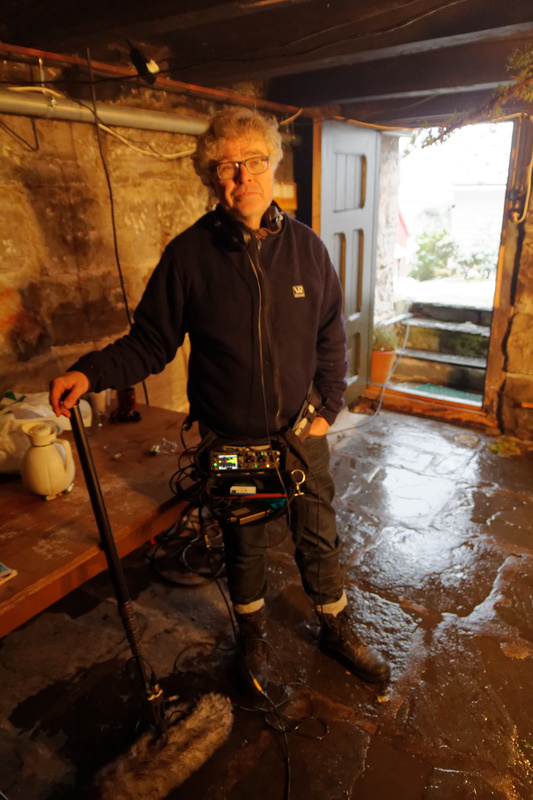
Morten, wearing the audio kit |
You may have noticed that the photos above are unusually well lighted for being taken in a dark brew cellar. The reason is that my friend Morten works for the Norwegian version of the BBC, and he'd managed to convince his boss to let him make a news segment for the Saturday news. This was just before Christmas, and my book had just come out, so a news story on the author of this farmhouse ale book visiting traditional brewers making their Christmas beer made for a good story.
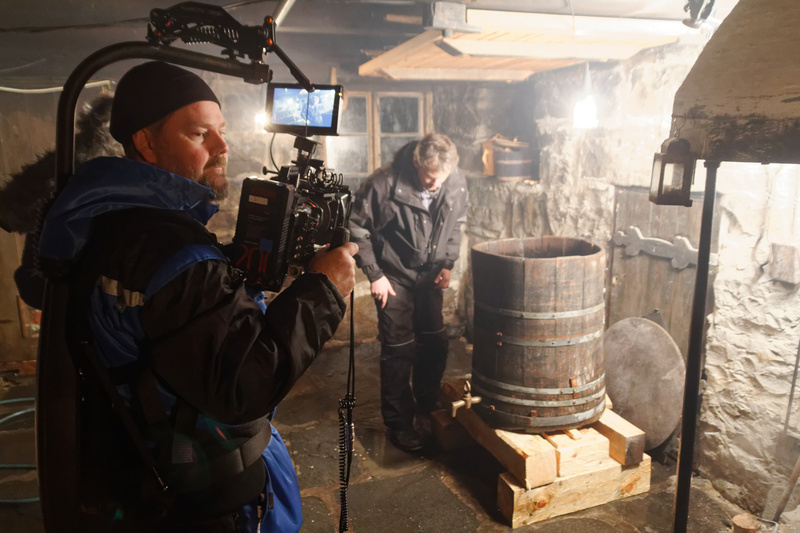
Anton, getting ready to film |
That hanging lamp you see in the hop filtering photo doesn't actually belong in the cellar. It was placed by the photographer, Jon Anton Brekne, a master of the art. The photos above were taken when they were not filming, carefully framed to not include the photographer wearing what looked like a space suit, but was actually his camera, and the microphone stand (see above).
As we were instructed what to say and do, and sometimes instructed to do the same things repeatedly, I recognized the strange tone of our voices, because I'd heard it before. I'd wondered about the weird way the two brewers in the 1973 movie talked to each other, but now I knew why it didn't feel quite right. It was because they didn't normally actually talk about what they were doing, they were doing it for the benefit of the film crew.
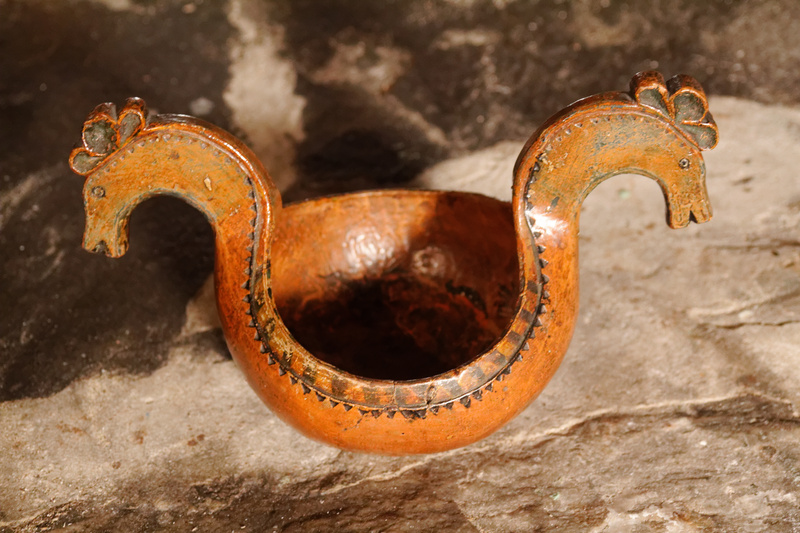
This type of bowl with horse head handles is called a "kjenge". Very common in Hardanger and particularly Voss. |
This, by the way, is also why Jakob dropped so much sugar into the beer. Beer for guests and celebrations had to be the very best, which meant as strong as possible. Now they were brewing for TV, so of course everything had to be tip-top.
After the brewing was finished we filmed an extra scene, because Morten wanted the film to end with oppskåke, the traditional party when the beer is racked. So we sat there in a semi-circle, drinking water from a wooden bowl, because the beer hadn't started fermenting yet. Dead tired after working hard for 12 hours straight we had a hard time getting it right. We tried to use the usual oppskåke phrases like "oh, this is proper strong stuff, I can tell you had a long way to the well when you brewed this." Then we'd remember we were drinking water, and break out into uncontrollable giggling. For some reason this scene wasn't included in the final film.
Anyway, I really recommend watching the actual news segment, even if you don't understand Norwegian. You get to see the process, and Anton's gorgeous filming really gives you a sense of where we were.
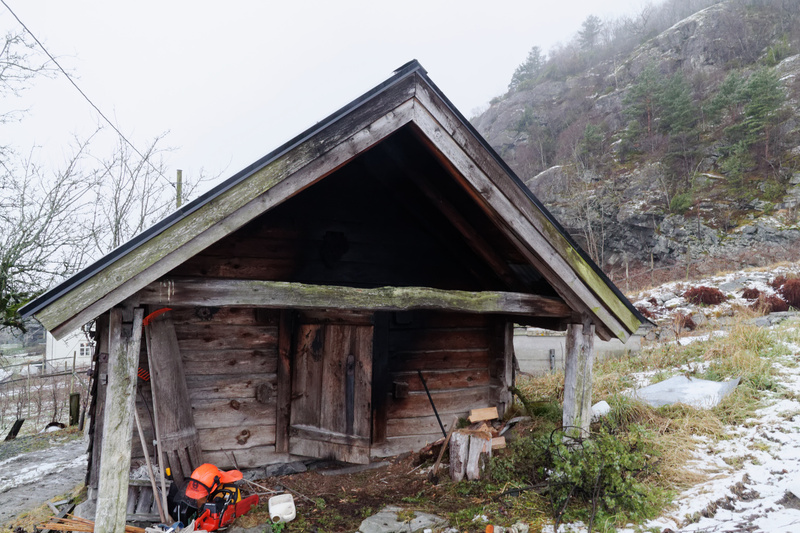
Traditional malt kiln, Aga |
Agatunet
We didn't film this in the brewhouse the brothers normally use. To get a better setting, they brewed at Agatunet, one of the few cluster farmyards remaining in Western Norway. In Eastern Norway the farms were spread out, but in Western Norway people lived in clusters of 20-50 houses, with the fields surrounding the village. And the actual building we were brewing in was a regional magistrate's court, built in 1270. The upper floors are made from wooden logs interlocking at the corners. It's still the same original logs from 1270.
The cellar has been rebuilt since, but the well behind a door in the corner is original. We spoke to a local historian who agreed that people must indeed have been brewing beer in that cellar since 1270.
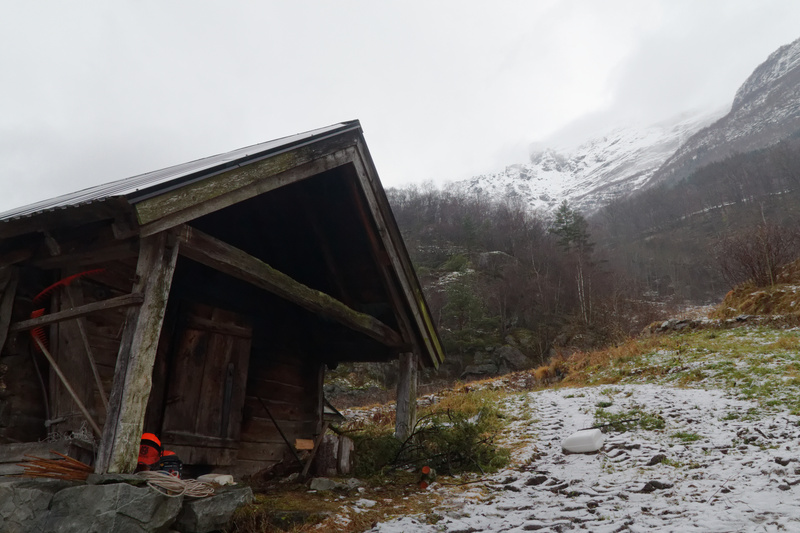
Looking up at the Folgefonna glacier behind the malt kiln |
Similar posts
The true meaning of Christmas
People often lament that we need to pay more attention to the true meaning of Christmas, but I don't think they mean the same thing as me when they say that
Read | 2020-12-15 19:50
A short history of the Baltic countries
We don't know much about the history before the advent of writing in the Baltics in the 12th century
Read | 2013-09-15 16:39
Tasting at Haandbryggeriet
In April a group of beer enthusiasts booked a tour at Haandbryggeriet where we were shown around the brewery and tasted some of the beers
Read | 2008-09-03 21:44
Comments
Martin Mæhle - 2019-01-22 16:34:40
hi Lars. i have just order a vial of #14 (and #48) from svein arild. and i just have to ask if you know ca, how much they had in the kettle before boil? and would it be okay to add a kilo or two of stjørdalsmalt? i see they used to smoke the malt.